An average of 288 deaths per day
In 2021, a total of 116,916 deaths were registered by place of occurrence, and 105,178 deaths by usual residence in the National Capital Region (NCR). There is an increase of 24.7 percent from the total deaths of 84,355 in 2020 with usual residence in NCR. This is equivalent to a crude death rate1 of 7.5, or 8 deaths per 1,000 population in 2021. This corresponds to an average of 288 deaths per day, which translates to 12 deaths per hour. (Figure 1 and Table 1)
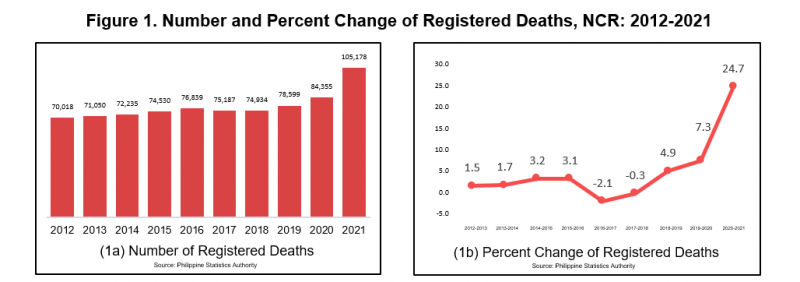
The number of registered deaths from 2012 to 2021 has trended upward except in the years 2017 and 2018. The increase during the ten-year period was 50.2 percent, from 70,018 in 2012 to 105,178 in 2021. (Figure 1 and Table 1)
One in every four deaths in NCR occurred in Quezon City
The highest number of registered deaths by place of occurrence was reported in Quezon City with 31,931 (27.3% share) followed by the City of Manila with 22,330 (19.1% share), and the City of Caloocan with 10,672 (9.1% share). The combined share of these three cities was 55.5 percent of the total registered deaths in the region. On the other hand, Pateros (454 or 0.4% share), City of San Juan (1,487 or 1.3% share), and City of Navotas (1,553 or 1.3% share) had the least number of total registered deaths in the region. (Figure 2 and Table 2)
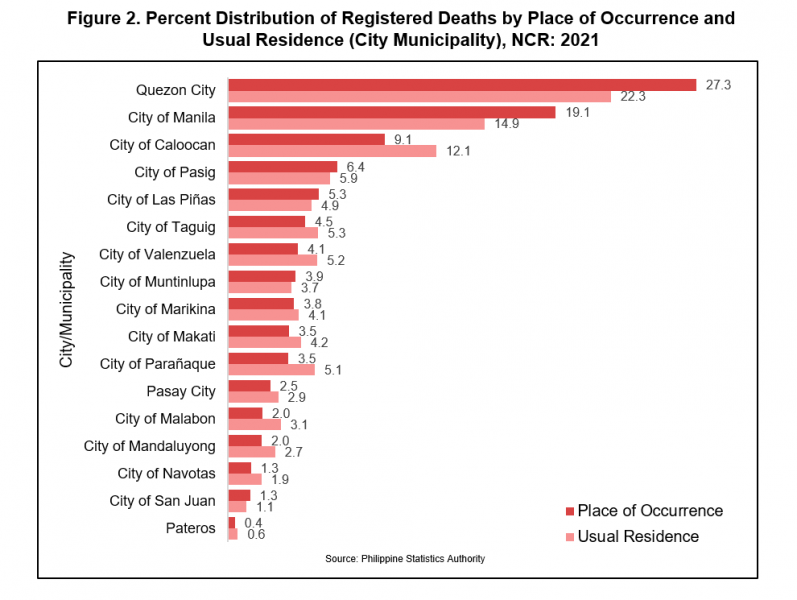
September had the most number of deaths
In 2021, the average number of deaths registered per day was highest in September at 453, followed by the months of April and August at 445 and 418, respectively. Meanwhile, the month of December registered the lowest average death per day with 234. Figure 3 and Table 3)
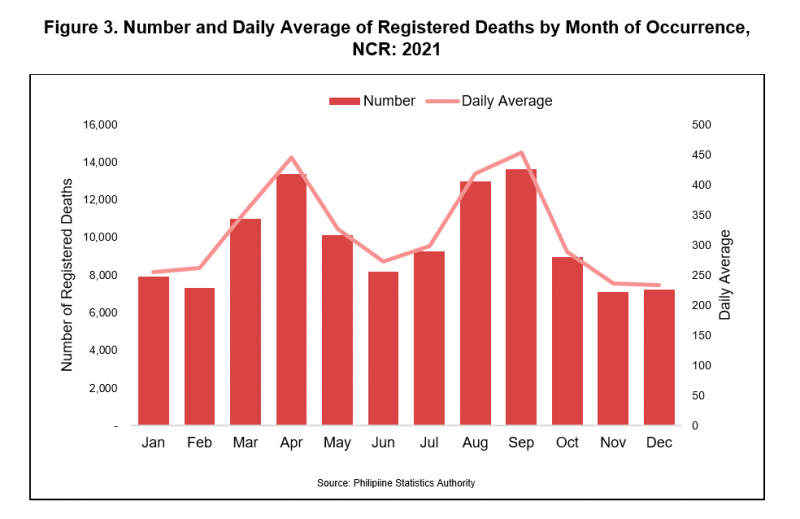
More male deaths than female deaths recorded
Figure 4 shows the age-sex structure of registered deaths by place of occurrence in 2021. It shows an inverted pyramid, with fewer deaths at younger ages, except for children under one, and progressively increasing as people grow older. The number of registered male deaths in NCR (65,672 or 56.2% share) was higher than female deaths (51,244 or 43.8% share). The proportion of males who died was highest at the age of 65 to 69 years old (7,828 or 11.9% of total male deaths) while for females, the largest was at the oldest age group, 85 years old and over (7,481 or 14.6 of total female deaths). The sex ratio of 128 indicates that there were about 128 male deaths for every 100 female deaths. Moreover, a sex ratio of over a hundred means that more male deaths were registered compared to their female counterparts in every age group spanning 0 to 74 years. (Figure 4 and Table 4)
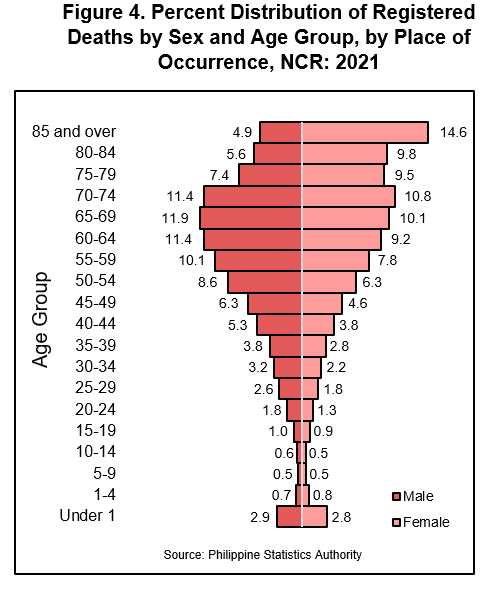
Seven out of ten deaths were attended by a healthcare provider
Attendant refers to a private physician, public health officer, hospital authority, or any other allied healthcare provider who provided medical attendance to the deceased. Out of 105,178 registered deaths with usual residence in NCR, 68.2 percent were medically attended (by private physicians, public health officers, hospital authorities, and other medically trained professionals), and the City of Taguig reported the highest percentage at 92.0. (Figure 5 and Table 5)
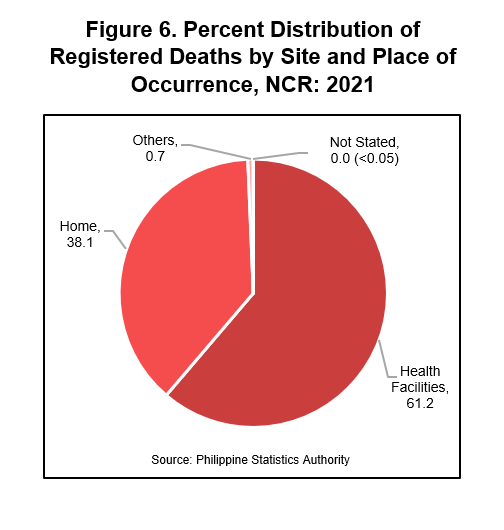
Four out of ten deaths occurred at home
Of the total registered deaths with usual residence in NCR, 61.2 percent occurred in health facilities while 38.1 percent occurred at home, and about 0.7 percent occurred in places other than health facilities and homes, such as on the street, in public places, on board a vehicle, airplane or vessel while in transit, among others. City of San Juan reported the highest percentage of deaths occurring in health facilities at 77.9 percent. (Figure 6 and Table 6)

Highest number of infant deaths recorded in Quezon City
Infant deaths are deaths that occurred before reaching age 1. In 2021, a total of 2,839 infant deaths were reported with usual residence in NCR. This translates to an average of about 8 infant deaths per day. Six out of ten infant deaths were males (1,610 or 56.7% share). Cities with large populations topped the list with the highest number of infant deaths led by Quezon City (672 or 23.7% share), the City of Manila (419 or 14.8% share), and the City of Caloocan (305 or 10.7% share). (Figure 7 and Table 7)
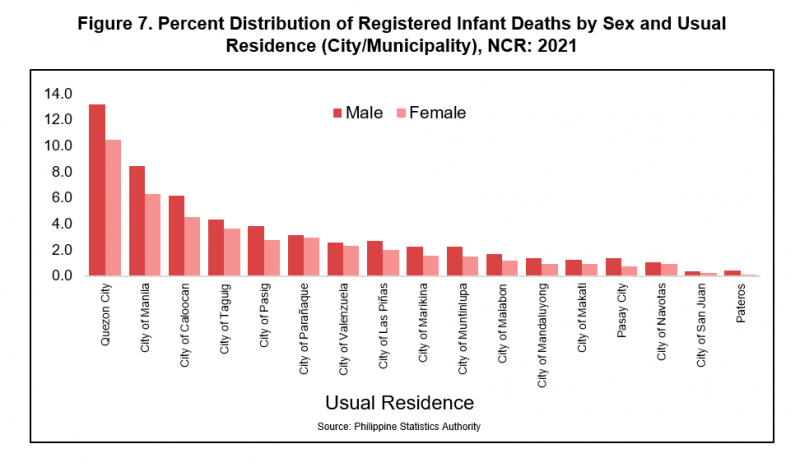
Highest number of maternal deaths was recorded in Quezon City
Maternal death is defined by the World Health Organization as, “the death of a woman while pregnant or within 42 days of termination of pregnancy, irrespective of the duration and the site of the pregnancy, from any cause related to or aggravated by the pregnancy or its management, but not from accidental or incidental causes.” In 2021, a total of 314 were identified as having died of maternal causes in the region. Quezon City recorded the highest number of maternal deaths in NCR with 69 or 22.0 percent. On the other hand, the municipality of Pateros reported no maternal deaths. (Figure 8 and Table 8)
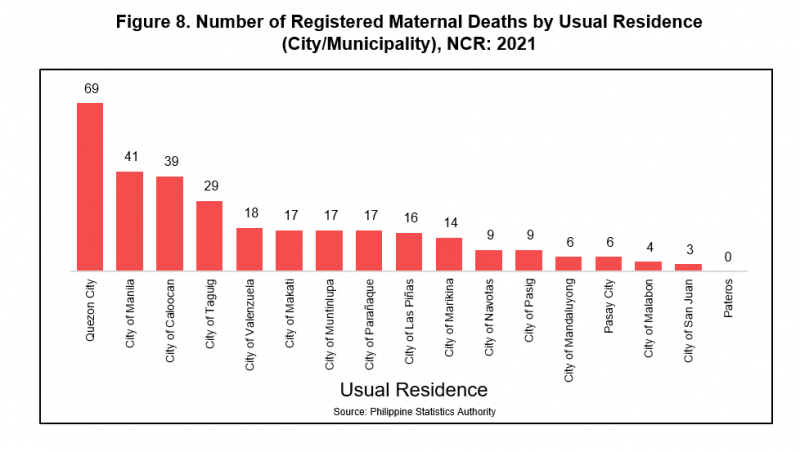
Quezon City recorded the highest number of fetal deaths
Fetal death refers to the death of a fetus irrespective of the duration of pregnancy prior to the complete expulsion or extraction of a product of conception from the mother’s womb. In 2021, a total of 1,573 fetal deaths were reported. By usual residence of mother, Quezon had the highest number with 346 or 22.0 percent followed by the City of Manila (206 or 13.1% share) and the City of Valenzuela (127 or 8.1% share). (Figure 9 and Table 9)
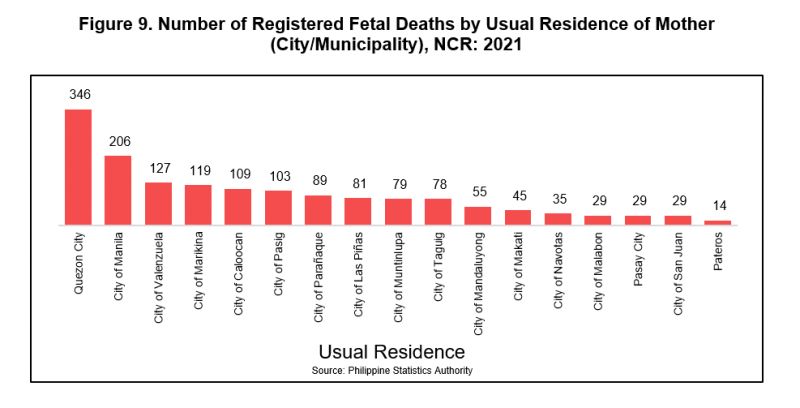
One in every four deaths in NCR is caused by Ischaemic Heart diseases
Deaths due to ischaemic heart disease led the cause of death in 2021 making up 25.6 percent (26,922) of the total registered deaths with usual residence in NCR. This was followed by deaths due to Coronavirus disease 2019 (COVID-19), virus identified at 14.1 percent (14,849), and Neoplasms at 8.7 percent (9,134). (Figure 10 and Table 10)
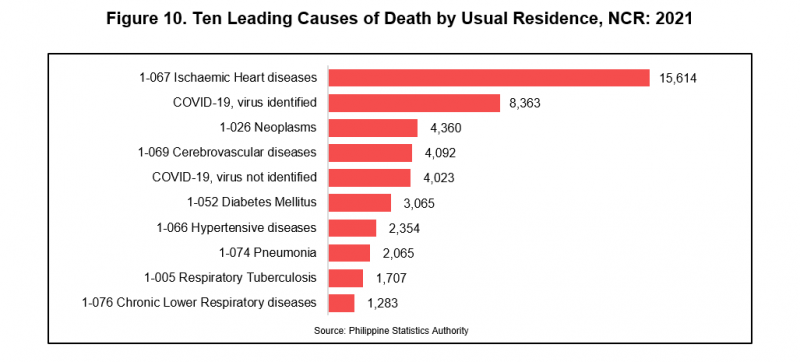
About 98 percent were registered on time
Registration of death shall be made in the office of the Civil Registrar of the city/municipality where the death occurred within thirty (30) days from the time of death. In 2021, 98.2 percent of deaths were registered on time while 1.8 percent were registered late. The City of Navotas recorded the highest percentage of timely registration with 99.5 percent while the City of Mandaluyong recorded the lowest percentage with 95.5 percent.
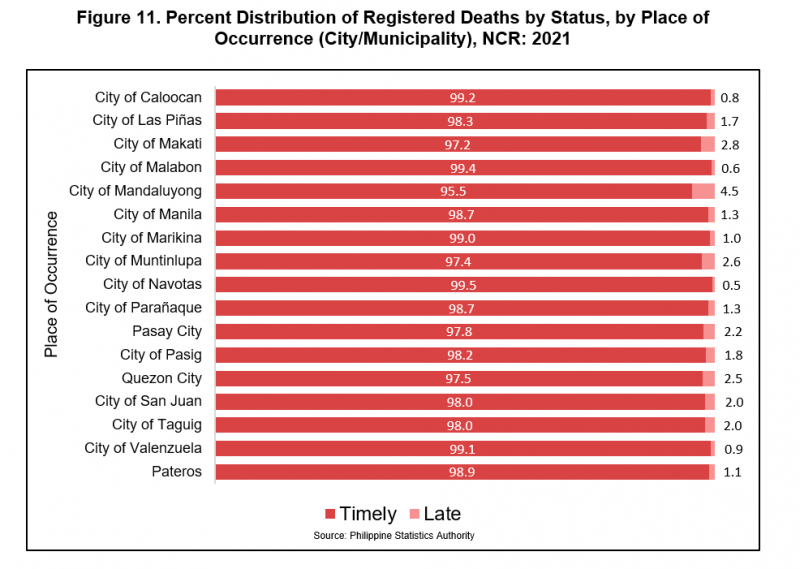
SGD.
PACIANO B. DIZON
Regional Director
Technical Notes
Vital statistics are derived from information obtained at the time when the occurrences of vital events and their characteristics are inscribed in a civil register.
Vital acts and events are the births, deaths, fetal deaths, marriages, and all such events that have something to do with an individual’s entrance and departure from life together with the changes in civil status that may occur to a person during his lifetime. Recording of these events in the civil register is known as vital or civil registration and the resulting documents are called vital records.
Death is a permanent disappearance of all evidence of life at any time after live birth has taken place (postnatal cessation of vital function without the capability of resuscitation).
Crude Death Rate (CDR) refers to the number of deaths per 1,000 mid-year population.
Sex Ratio refers to the number of males per one hundred females.
Usual Residence refers to the place where the person habitually or permanently resides.
Place of Occurrence refers to the place where the vital event took place.
Attachments:
1. Table 1. Number and Percent Change of Registered Deaths, National Capital Region: 2012-2021
2. Table 2. Number and Percent Distribution of Registered Deaths by Sex and by Place of Occurrence and Usual Residence (City/Municipality), National Capital Region: 2021
3. Number, Percent Distribution, and Daily Average of Registered Deaths by Month of Occurrence, National Capital Region: 2021
4. Number and Percent Distribution of Registered Deaths by Sex, Age Group, and Sex Ratio, by Place of Occurrence, National Capital Region: 2020-2021
5. Table 5. Number and Percent Distribution of Registered Deaths by Attendant and Usual Residence (City/Municipality), National Capital Region: 2021
6. Table 6. Number and Percent Distribution of Registered Deaths by Site and Place of Occurrence (City/Municipality), National Capital Region: 2021
7. Table 7. Number and Percent Distribution of Registered Infant Deaths by Sex and Usual Residence (City/Municipality), National Capital Region: 2021
8. Table 8. Number and Percent Distribution of Registered Maternal Deaths by Usual Residence (City/Municipality), National Capital Region: 2021
9. Table 9. Number and Percent Distribution of Registered Fetal Deaths by Usual Residence of Mother (City/Municipality), National Capital Region: 2021
10. Table 10. Ten Leading Causes of Death by Sex by Usual Residence (City/Municipality), National Capital Region: 2021
11. Table 11. Number and Percent Distribution of Registered Deaths by Registration Status, by Place of Occurrence (City/Municipality), National Capital Region: 2021
